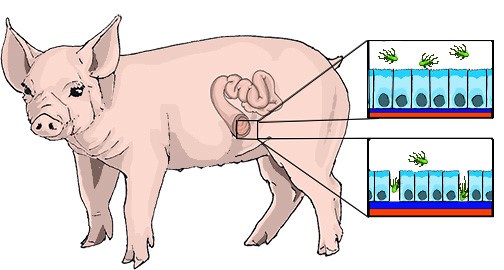Weaning Woes, an Overview of Weaning Stress in Piglets
Stress can negatively impact young animals faster than adult animals.
Let’s start with a question. What is stress? It’s a word commonly used to describe the feeling people experience when they’re undergoing strain, which can be physiological (such as prolonged exposure to intense heat) or emotional (for example, loss of a loved one) or a combination of both. But what is happening in the body when someone experiences stress?
To keep it simple, when stress inducing events are short lived, stress is a protective mechanism. Examples of short term stress events include slamming on the breaks when driving to avoid hitting another car or being attacked by an animal or person. During short lived stress episodes chemical mediators, such as adrenaline, are released to promote muscle tenseness and increases in respiration and heart rate to effectively prepare the body for possible incoming pain or injury. This is a normal function. However, when stress is prolonged, those responses negatively impact individuals and can decrease functional capabilities of all body systems.
Stress can negatively impact young animals faster than adult animals. It is well known that weaning is an intensely stressful event that young animals face, due to reduced contact with mothers and siblings and physiological stress as young animal experience considerable dietary changes. This stress can result in increased susceptibility to diarrhea, infection and less growth.
Gastrointestinal (GI) disorders are of particular concern when weaning piglets. One of the main defenses of the intestines is the gastrointestinal epithelium, which lines the inside of the intestines and is composed of a cell type which absorbs nutrients from digested feed while providing a protective barrier against disease-inducing agents, like bacteria and viruses. However, in very early weaned piglets, the GI epithelium is not yet fully formed, and when compromised, results in disruption of tight junctions between the cells and predisposes neonates to GI diseases, like edema disease caused by Escherichia coli infections (Masri et al, 2015).

Diagram 1. Normal (top box) versus compromised (bottom box) gastrointestinal epithelium in piglets.
Using a stress model whereby pigs were mixed 7 days after weaning and higher density than control pigs, these chronically stressed pigs had damage of the gut barrier and reduced nutrient uptake, resulting in lower body weight gain and feed efficiency (Li et al, 2017). This research led by Dr. Adam Moeser, an endowed chair and associate professor in the College of Veterinary Medicine (Michigan State University) focus investigates how the process of weaning can promote GI disorders or diseases. When comparing early weaning age to a later age at weaning, there was less mast cell degranulation (typically associated with allergies-think of swelling after a wasp sting). Early weaning resulted in increased mucosal permeability and enhanced mast cell degranulation compared to late weaned mucosa. Early weaned pigs (16 d and 18 d weaning age) exhibited a more rapid onset and severity of diarrhea and reductions in weight gain in response to ETEC challenge compared with late weaned pigs. In a separate publication authored by Pohl et al, (2017), early weaned female piglets expressed more mast cell mediators and had more intestinal permeability and diarrhea than early weaned male pigs. Interestingly, women are 4 times more likely to have stress-related gastrointestinal disorders such as Irritable Bowel Syndrome (IBS).
Other research support these results and found that weaning piglets prior to 28 days of age results in massive changes to the structure of the gastrointestinal epithelium and as such, loss of protective functions. Interestingly, and importantly, it was found that there were nearly no negative changes in the gastrointestinal epithelium when weaning was delayed to 35-day of age (Masri et al, 2015).
Stress is never enjoyable, and may prove to increase sickness to bacteria and virus when experienced too early in life. Later weaning may benefit both piglets and producers by reducing the prevalence of GI diseases in piglets, thus improving piglet welfare and increasing profit margins. We also wonder what we might be overlooking when we compare weaning age and gender in production data.



 Print
Print Email
Email
